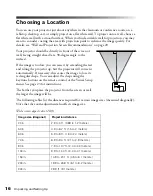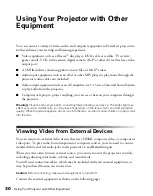
Playing discs
21
Viewing on a Wall
You can easily view your PowerLite projector’s high quality images on any flat white wall.
There is no cost or setup involved, and you can project and resize the image up to any size
that fits on your wall. To enhance the image quality even further, you may want to paint the
wall with projection paint that is specially designed for optimum reflectivity and contrast in
your viewing environment.
Considering Surface Quality
Screen surface quality can also affect the reflectivity of light in your projected image. Screen
reflective properties are measured as “gain” rates, with 1.0 gain as the reflectivity of a white
board. Highly reflective screen surfaces (above 1.0 gain) create a brighter image, but the
brightness may not be uniform enough for a dedicated home theater environment and the
colors may appear to shift from different viewing angles.
In a room with darkened surroundings and controlled lighting, a screen surface with less than
1.0 gain is best. For rooms where you cannot control the light or will always have ambient
light, you may want to select a screen surface with more than 1.0 gain to compensate for the
additional brightness.
Wall-mounted screens
Typically permanently installed
Can be partially hidden out of the way
Some may be disguised as artwork
Ceiling-mounted screens
Typically permanently installed
Can be partially hidden out of the way
Some may be recessed into the ceiling and hidden completely
Can be manually or electronically dropped and raised
Outdoor screens
Resistant to outdoor environmental factors
Can be used on patios, and around pools and landscaping
Usually made of inflatable plastic or vinyl
Screen mounting style
Characteristics














































